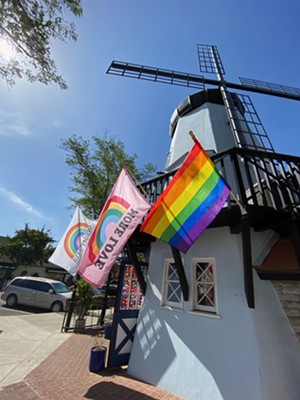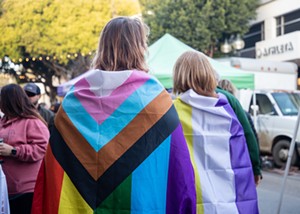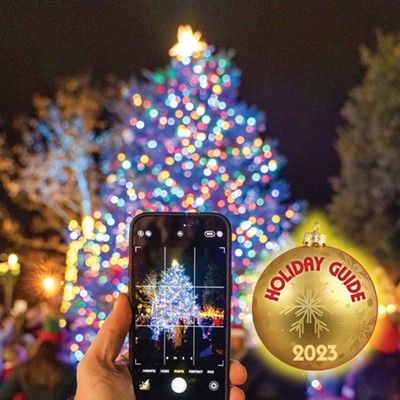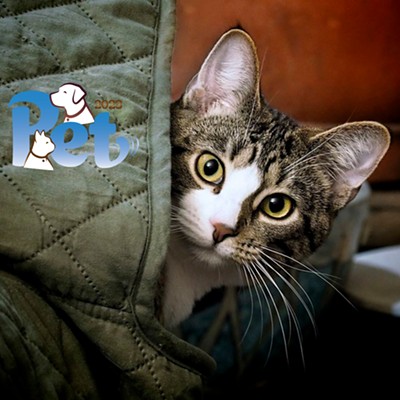Our annual Pride issue is coming a little early this year, but is it ever really too early to celebrate the activism and visibility of the LGBTQ-plus community? We talk to the Pacific Pride Foundation about the upcoming summer of in-person events, why it’s important to remember the activist roots of Pride, and the current legislative threats facing the LGBTQ-plus community, and we speak with a trans woman who found the solace and space she needed during the pandemic to become the person she is today.
2022 anti-LGBTQ-plus and anti-transgender legislation returns political movement to Pride celebrations
BY TAYLOR O'CONNOR
Rainbow flags. Glitter-adorned faces. Bright-colored clothes. “Love is Love” signs.
Cities across America celebrate Pride Month with their own festivals every year—and although it’s important to celebrate, it’s also important to remember why it’s celebrated, said Kristin Flickinger, the executive director for Santa Barbara County nonprofit Pacific Pride Foundation
“It’s not just a celebration. Pride sits in social wellness and individual wellness; it’s advocacy related, it’s policy related,” Flickinger said. “We are celebrating, [but also] connecting people to services and being visible—which is a show of activism.”
The celebrations

Opportunities to gather span up and down the county with celebrations in Santa Maria, the Santa Ynez Valley, and Santa Barbara.
Santa Maria’s House of Pride and Equality (HOPE) board member Eva Didion told the Sun via email that its usual Pride Fest and Resource Fair will not be held this year, but residents are welcome to attend its Pride Drag Show at Presqu’ile Winery on June 18 featuring eight drag queens, food trucks, and VIP tables available for purchase.
Pacific Pride Foundation will be returning with its free pride festival on Aug. 27 at Chase Palm Park in Santa Barbara with resource booths, music, and vendors. More information will be available on its website as the date gets closer, Events Manager Jackie VanLingen told the Sun.
The Santa Ynez Valley will be having its first pride week through the newly founded nonprofit SYV Pride—an organization that was created after a last-minute Pride party in 2021, which attracted more than 150 people. The Solvang City Council recently approved the celebration after some residents’ opposition, but valley residents have otherwise been supportive of the latest addition to its communities, SYV Pride Founder Golzar Meamar said.
“Our whole purpose is to shine the light on the LGBTQ community, to achieve equality and justice, and we are going to do that through education and celebration. This Pride festival is going to be a turning point for this valley,” she said.
The celebration will be held from June 22 to 26 with a kickoff party, a parade and festival, and a drag brunch. Meamar added that she expects more than 500 people to attend, pulling residents from San Luis Obispo and Los Angeles.
“In general, when we celebrate as a community, we’re showing that we can come together and uphold the dignity of our friends and neighbors because we are uplifting individuals’ self-worth and inspiring others to fight,” Meamar said.
Why we celebrate
Pride activism and celebration across the country began after the Stonewall Riots in June 1969 when New York City police raided the Stonewall Inn—a gay club located in Greenwich Village—and hauled employees and patrons out of the bar, sparking six days of protests and violent clashes with law enforcement.
Now, Pacific Pride Foundation Executive Director Flickinger said, it’s important to remember the celebration’s activist roots as hundreds of anti-LGBTQ-plus and anti-transgender bills have been introduced in legislatures throughout the United States.
“There’s a lot going on right now. We’ve been seeing these attacks on transgender youth across the country over the past year, everything from Florida and Texas, and things proposed in Tennessee. There’s at least a dozen bills that will mirror Florida’s bill where folks seek to prohibit discussing topics of gender identity or gender orientation,” she said.
According to NBC News, state lawmakers proposed a record-breaking 238 bills—skyrocketing from 41 in 2018—that would limit the rights of LGBTQ-plus Americans this year, with about half targeting transgender people specifically.
“The slate of legislation includes measures that would restrict LGBTQ issues in school curriculums, permit religious exemptions to discriminate against LGBTQ people, and limit trans people’s ability to play sports, use bathrooms that correspond with their gender identity, and receive gender-affirming health care,” the article stated.
Supporters of these bills say they are protecting children, parental rights, and religious freedom, and Flickinger said she’s concerned about the repercussions this will have on the youth she serves in her community and across the country.

“In California, some people may think this doesn’t touch us, but according to the Trevor Project, 94 percent of trans youth reported that politics negatively impact their mental health,” she said. “One bill can impact mental health; imagine if you have this constant barrage of bills commenting if you have the right to exist, and how that might affect one’s mental health.”
That trajectory doesn’t seem to be stopping either, she said, with the recently leaked U.S. Supreme Court’s ruling that could overturn Roe v. Wade—a historical decision that granted a woman’s right to an abortion due to the 14th Amendment, which provides a right to privacy.
“I think the latest attack on reproductive rights is a string of things we’ve been seeing, and already folks were talking about how this decision is linked to other privacy-related rights including the right to marry. We’re putting it all in context that this is part of a larger context,” she said.
Gay marriage became legal in June 2015 with a ruling that also fell under the constitutional right to privacy, saying same-sex couples can’t be deprived of that right. High scrutiny and rights removal is nothing new to LGBTQ-plus communities, but that doesn’t make it less distressing, Flickinger said.
“The things that will keep me up at night in the coming months are the contexts that we are living in what appears to be rolling out in front of us—a systematic stripping of rights for a whole lot of people. That is not something that we have seen at this magnitude before,” she said.
Despite all of this, Flickinger remains hopeful because of the community’s resilience. While there are a lot of lingering concerns, there’s a lot of power behind LGBTQ-plus people, she said.
“We come out of protest, desperate parts of society, uniting around a common purpose, which is justice in the pursuit of joy,” Flickinger said. “It’s about rising up in order to be able to live joyous, full lives, and I have a lot to hope for in that.”
Reach Staff Writer Taylor O’Connor at [email protected].
For some transgender people, the pandemic created unexpected safe places to find their truest selves
BY MALEA MARTIN
When Jackie Martin looks back on her childhood, she remembers feeling like something was off—like the puzzle pieces of her identity weren’t quite fitting together.
“There were definitely times when I was a really little kid where I had the feelings but not the words for it,” Martin said. “I was starting to piece things together, and I came to somewhat of a semi-clear realization in early senior year [of high school].”
Martin graduated high school in 2019 and headed to college. After just one semester, the pandemic hit and like many young adults, she found herself back in her childhood bedroom. That’s when Martin accepted what she couldn’t deny any longer: She’s transgender.
Today, she is out as a trans woman—she also happens to be my younger sister and one of my best friends. She told me about how the pandemic turned her “semi-clear realization” into an unequivocal one.
“It was late March [2020] at 3 in the morning, and I went online and took an ‘Am I Trans?’ quiz,” Martin remembered with a laugh. “I told myself, I’ve got to be honest in answering these. Every question I was hitting ‘strongly agree’—and I started to realize, ‘Oh my God, this is real.’”
Martin didn’t need an online quiz to know she was trans. In a way, she had always known. But she said hearing it from a neutral voice that wasn’t her own was the validation she needed to finally accept who she is.
If it weren’t for the pandemic, she thinks it would have taken her a lot longer to come to that place of self-acceptance.
“Because I was just kind of in my room alone, I really had to face myself,” Martin said. “I didn’t have much else to do but look in my mirror, and that’s when I really started feeling the dysphoria.”
Dysphoria is feeling misaligned between who you are and your assigned body, Martin said. It feels like “your soul is wearing its shoes on the wrong feet, combined with the external pressures of the world seeing you fundamentally as something you’re not.” She described it as crushingly painful.
“It was definitely there in my earlier years, but it just exponentially ramped up during the pandemic because I was just forced to be with myself at the time when my body was starting to really change in the way I definitely did not want it to,” Martin said.
Martin isn’t alone in her pandemic-induced coming out: According to Jamie Woolf, chair of Tranz Central Coast, a flood of calls came into her organization after 2020.
“After about a year of the pandemic, we started getting a lot of contacts from parents saying, ‘My child just came out as trans, or nonbinary, or somewhere in the gender-variant world,’” Woolf said. “It was surprising how many we got, and we had the sense that maybe it was these kids sitting home, just reading the internet without a lot else to do. They were finally having these hard discussions.”
While the isolation of the pandemic was challenging for everyone, including the trans community, Woolf said it also allowed some folks to start coming out without having to think about what others might say.
“They didn’t know how their friends would deal with it in school, how their parents would deal with it,” Woolf said. “Finally being stuck at home where their friends aren’t really seeing them, they finally start to come out. It seemed like one of the unexpected bright parts of this pandemic.”
For Martin, spending time alone wasn’t the only pandemic-borne change to daily life that accelerated her coming-out journey.
“In the early stages of the pandemic, I remember thinking it’s great we’re all wearing masks, because it made me feel like I could go out in public when my dysphoria was at its worst,” Martin said. “It was a great way to feel good enough to go out in public even if I wasn’t fully passing yet.”
Passing means that people perceive you as the gender you identify with. For most cisgender people—those who identify with the gender they were assigned at birth—passing isn’t something you think twice about. It’s a given that most cisgender people pass. But for Martin and a lot of trans people, passing is monumentally affirming, a feeling of pure euphoria.
“The first time I did pass was when I was wearing a mask,” Martin remembers. “I was walking into Target, and there was one of those people trying to get an amendment passed or whatever. She was like, ‘Excuse me, ma’am, are you a California voter?’ It was a wild feeling. My adrenaline was pumping but in a good way. For the rest of the day I was smiling.”

The shift to virtual spaces also proved to be a helpful tool to bring the trans community together. Allie Rae Hampton, a community activist and facilitator for the Gala Pride and Diversity Center, started a Facebook social group for the local trans community during the pandemic. The group is private and by invitation only, making it a safe place for trans people who might not be out to their friends or family yet. Hampton started hosting weekly Zoom peer support groups.
“I learned that it was really possible for a lot more people to show up and be virtually with their peers instead of coming to an in-person event,” Hampton said. “I feel like more people have found that it’s safe to come out. I don’t think the actual quantity of [trans] people has changed, but I do know that someone who’s closeted can actually join a Zoom group and it’s safe, and you don’t even have to turn your video on if you don’t want to.”
Martin said transitioning during the pandemic wasn’t always easy—social isolation and COVID-19 anxiety were hard on her just like everyone else.
“But I think it got me to realize I was trans a lot sooner than I would have otherwise,” she said. “It made the early stages of transitioning easier because I didn’t have to constantly deal with ridicule in the workplace, ridicule from peers, ridicule from school. Those are struggles I was able to take on a year into transitioning, and by then I was more prepared for it.
“It wasn’t just all the struggles, all at once.”
Reach New Times Staff Writer Malea Martin at [email protected].













